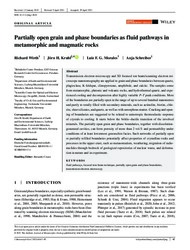Partially open grain and phase boundaries as fluid pathways in metamorphic and magmatic rocks
DOI: https://doi.org/10.1111/jmg.12610
Persistent URL: http://resolver.sub.uni-goettingen.de/purl?gldocs-11858/9875
Persistent URL: http://resolver.sub.uni-goettingen.de/purl?gldocs-11858/9875
Wirth, Richard; Kruhl, Jörn H.; Morales, Luiz F. G.; Schreiber, Anja, 2021: Partially open grain and phase boundaries as fluid pathways in metamorphic and magmatic rocks. In: Journal of Metamorphic Geology, Band 40, 1: 67 - 85, DOI: 10.1111/jmg.12610.
 |
Dokument öffnen: |
Transmission electron microscopy and 3D focused ion beam/scanning electron microscope nanotomography are applied to grain and phase boundaries between quartz, plagioclase, K‐feldspar, clinopyroxene, amphibole, and calcite. The samples come from metamorphic, plutonic and volcanic rocks, and hydrothermal quartz, and experienced cooling and decompression after highly variable P–T peak conditions. Most of the boundaries are partially open in the range of up to several hundred nanometres and partly to totally filled with secondary minerals, such as actinolite, biotite, chlorite, sheet silicates, and quartz, as well as with amorphous matter. Cracking and opening of boundaries are suggested to be related to anisotropic thermoelastic response of crystals to cooling. It starts below the brittle–ductile transition of the involved minerals. The partially open grain and phase boundaries, together with dissolution‐generated cavities, can form porosity of more than 2 vol.% and permeability under conditions of at least lowermost greenschist facies. Such networks of partially open or partially refilled boundaries potentially affect properties of crystalline rocks and processes in the upper crust, such as metasomatism, weathering, migration of radionuclides through bedrock of geological repositories of nuclear waste, and deformation in nature and in experiment.
Statistik:
ZugriffsstatistikSammlung:
Schlagworte:
fluid pathwaysfocused iron beam technique
partially open grain and phase boundaries
transmission electron microscopy
This is an open access article under the terms of the Creative Commons Attribution‐NonCommercial‐NoDerivs License, which permits use and distribution in any medium, provided the original work is properly cited, the use is non‐commercial and no modifications or adaptations are made.

